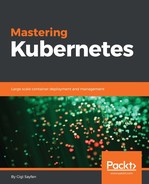Kubernetes is a big open source project with a lot of code and a lot of functionality. You have probably read about Kubernetes, and maybe even dipped your toes in and used it in a side project or maybe even at work. But to understand what Kubernetes is all about, how to use it effectively, and what the best practices are, requires much more. In this chapter, we will build together the foundation necessary to utilize Kubernetes to its full potential. We will start by understanding what container orchestration means. Then we will cover important Kubernetes concepts that will form the vocabulary we will use throughout the book. After that, we will dive into the architecture of Kubernetes proper and look at how it enables all the capabilities Kubernetes provides to its users. Then, we will discuss the various runtimes and container engines that Kubernetes supports (Docker is just one option), and finally, we will discuss the role of Kubernetes in the full continuous integration and deployment pipeline.
At the end of this chapter, you will have a solid understanding of container orchestration, what problems Kubernetes addresses, the rationale for Kubernetes design and architecture, and the different runtime it supports. You'll also be familiar with the overall structure of the open source repository and be ready to jump in and find answers to any question.
The primary responsibility of Kubernetes is container orchestration. That means making sure that all the containers that execute various workloads are scheduled to run physical or virtual machines. The containers must be packed efficiently following the constraints of the deployment environment and the cluster configuration. In addition, Kubernetes must keep an eye on all running containers and replace dead, unresponsive, or otherwise unhealthy containers. Kubernetes provides many more capabilities that you will learn about in the following chapters. In this section, the focus is on containers and their orchestration.
It all starts and ends with hardware. In order to run your workloads, you need some real hardware provisioned. That includes actual physical machines, with certain compute capabilities (CPUs or cores), memory, and some local persistent storage (spinning disks or SSDs). In addition, you will need some shared persistent storage and to hook up all these machines using networking so they can find and talk to each other. At this point, you run multiple virtual machines on the physical machines or stay at the bare-metal level (no virtual machines). Kubernetes can be deployed on a bare-metal cluster (real hardware) or on a cluster of virtual machines. Kubernetes in turn can orchestrate the containers it manages directly on bare-metal or on virtual machines. In theory, a Kubernetes cluster can be composed of a mix of bare-metal and virtual machines, but this is not very common.
Containers are ideal to package microservices because, while providing isolation to the microservice, they are very lightweight and you don't incur a lot of overhead when deploying many microservices as you do with virtual machines. That makes containers ideal for cloud deployment, where allocating a whole virtual machine for each microservice would be cost prohibitive.
All major cloud providers, such as AWS, GCE, and Azure, provide container hosting services these days. Some of them, such as Google's GKE, are based on Kubernetes. Others, such as Microsoft Azure's container service, are based on other solutions (Apache Mesos). By the way, AWS has the ECS (the containers service over EC2), which uses their own orchestration solution. The great thing about Kubernetes is that it can be deployed on all those clouds. Kubernetes has a cloud provider interface that allows any cloud provider to implement it and integrate Kubernetes seamlessly.
In the olden days, when systems were small, each server had a name. Developers and users knew exactly what software was running on each machine. I remember that, in many of the companies I worked for, we had multi-day discussions to decide on a naming theme for our servers. For example, composers and Greek mythology characters were popular choices. Everything was very cozy. You treated your servers like beloved pets. When a server died it was a major crisis. Everybody scrambled to try to figure out where to get another server, what was even running on the dead server, and how to get it working on the new server. If the server stored some important data, then hopefully you had an up-to-date backup and maybe you'd even be able to recover it.
Obviously, that approach doesn't scale. When you have a few tens or hundreds of servers, you must start treating them like cattle. You think about the collective and not individuals. You may still have some pets (that is, your build machines), but your web servers are just cattle.
Kubernetes takes the cattle approach to the extreme and takes full responsibility for allocating containers to specific machines. You don't need to interact with individual machines (nodes) most of the time. This works best for stateless workloads. For stateful applications, the situation is a little different, but Kubernetes provides a solution called StatefulSet, which we'll discuss soon.
In this section, we covered the idea of container orchestration and discussed the relationships between hosts (physical or virtual) and containers, as well as the benefits of running containers in the cloud, and finished with a discussion about cattle versus pets. In the following section, we will get to know the world of Kubernetes and learn its concepts and terminology.
